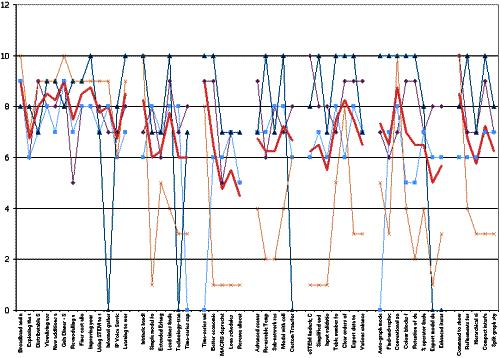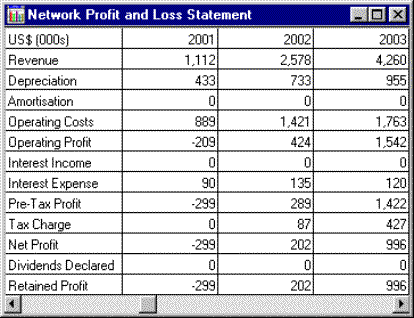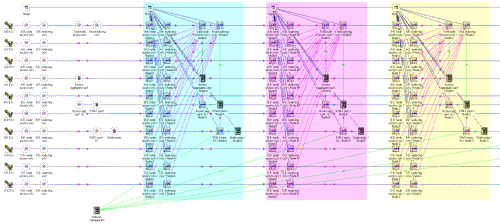An online survey was posted for delegates of the 2002 STEM User Group meeting to
assess the relative merits of a wide range of proposed developments to the STEM
modelling platform (as well as to comment on the User Group event itself). Development
priorities were separated into four categories: technical modelling, financial modelling,
model structure and the underlying modelling platform. We have made an initial assessment
of the responses so far, with thanks to those who have contributed. The not entirely
scientific conclusions are presented below.

Technical modelling
Although possibly the most nebulous section, in terms of the implied specification
of items listed, there are two clear leaders:
- Intrinsic handling of bandwidth services – Direct inputs to capture both
peak and mean bandwidth requirements, somehow reconciled with the current, voice-orientated
formalism.
- Lead times – Constraints on time to commission, cap on expenditure, cap
on incremental units (man-power); requires new distinction between desired and supported
demand.
Financial modelling
The clear leader in this section was time-series inputs for unit costs, followed
up by an improved model for economies of scale. However, we are also aware of several
requests to implement loan schedules, so the initial results may be unrepresentative.
- Time-series unit cost inputs – Overlaid with existing cost trends, with
additional inline trend for capital costs.
- Better economies of scale – Revised model based on real price points and
optional interpolation.
- Loan schedules – Optional finance elements modelling principal amount for
loan or investment, specifying interest rate and payment schedule, with any shortfall
made up with variable financing as normal.

Model structure
There is a very even spread of opinion on the structural topics, with collection-driven
modelling slightly ahead of the expected winner – advanced scenarios – and custom
transformations, and re-useable templates and sub-network results not far behind.
- Model with collections of services – E.g. as input to transformation or
source for Resource requirements (with potential to simplify model structure and
improve performance).
- Advanced scenarios – ‘Additive’ dimensions and built-in support for sensitivity
analysis.
- Custom Transformations – Possibly ‘coded’ through some interface to Visual
Basic.
Modelling platform
The interface issues were dominated by the demand for clear orders of magnitude
on graphs and table number formats, as well as simplified export of data to Excel.
- Clear orders of magnitude – Auto-selection of multiplier (in steps of 1000)
appended to unit label, e.g. USD (000s), for graph and table units.
- Table number format – Auto-selection of fixed decimal places according
to composite scale of tabled results, plus manual selection of custom number formats.
- Export data to Excel – Select data in STEM and replace with link to labels
and values in Excel.

Editor
The surprise favourite for developments specific to the Editor is the conventional
zoom facility, some way ahead of the new auto-graphing idea and shaded regions for
Collections.
- Conventional zoom facility – Control scale of view display: size of icons
versus coverage.
- Auto-graph mode – Option to allow an Editor graph window to follow the
current input field as you switch dialogs and inputs.
- Colour blocks for Collections – Additional presentational tools for views.

Results program
Although this last section rather overlaps with general modelling platform, again
there is a clear win for the command to show tables as well as graphs, revised from
the original request to show tables in the same window as a graph, as now implemented
in STEM 6.2.
- Command to show table as well as graph – In a separate window
- Compact interface – For sensitivity analysis with ‘tornado analysis’, i.e.
sorted bar graph of influence against parameter
- Refinements for results views – Future options to prompt or auto-fix on
change view, and also to suppress close-graphs prompt when view has not been modified
(e.g. just fixed)?
Have your say!
It’s not too late to add your input. The questionnaire form is still live, and we
will keep this open until the late summer. We really welcome your input, since maintaining
the tool in line with our current users’ requirements is the best way to keep its
features relevant to the prospective user. We will present the consolidated conclusions
to the next User Group meeting, the date and venue for which will be announced in
the April 2003 STEM newsletter.